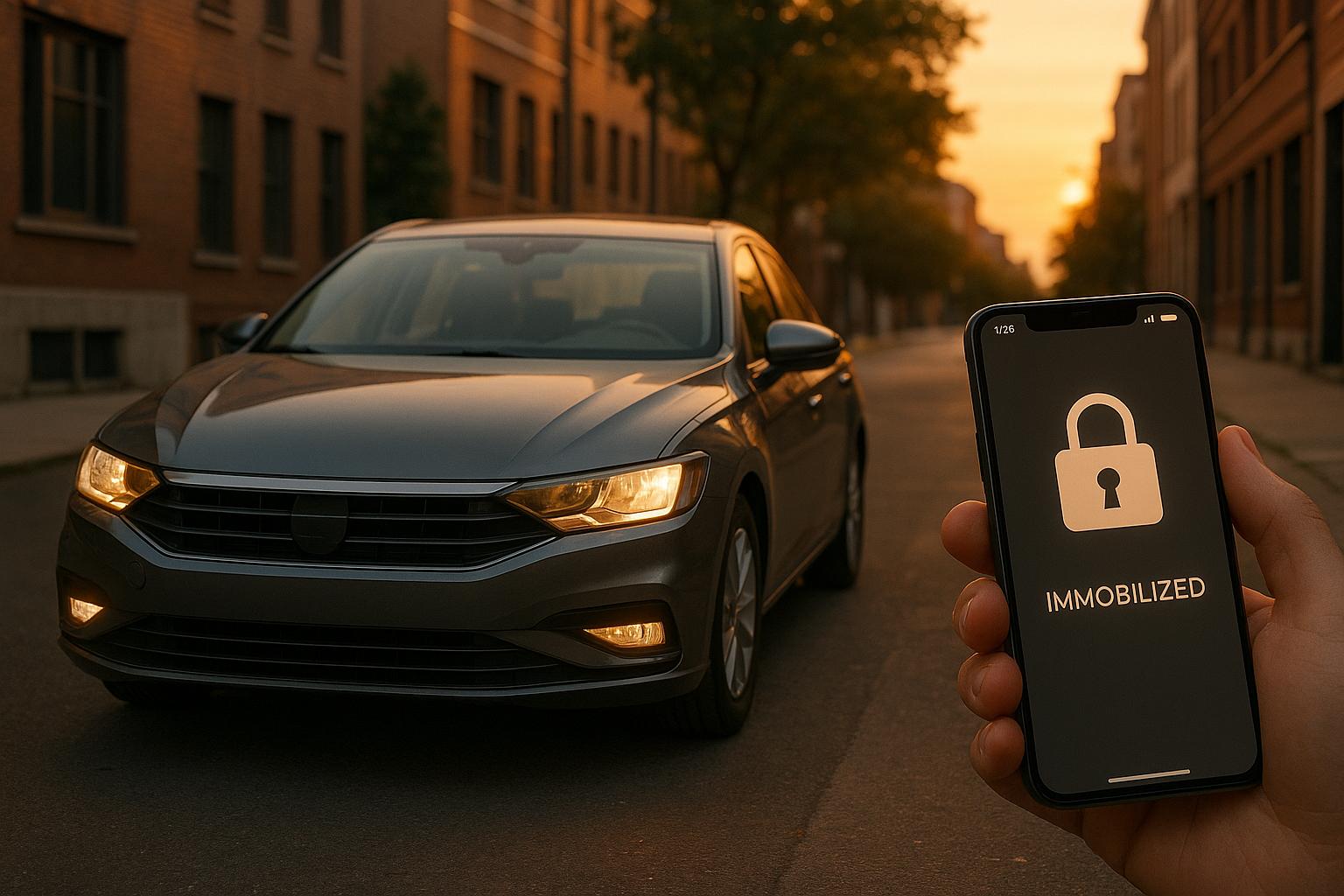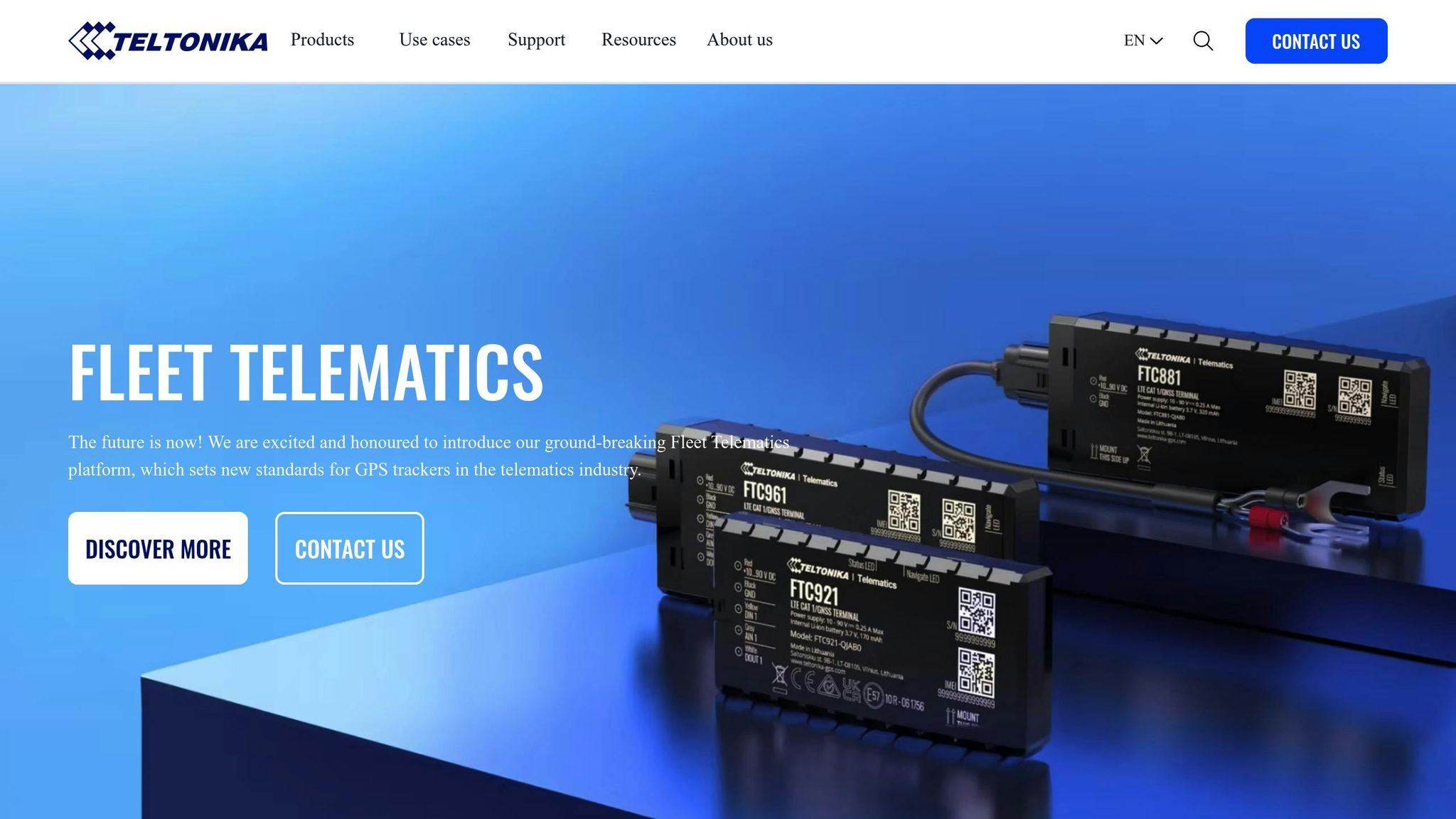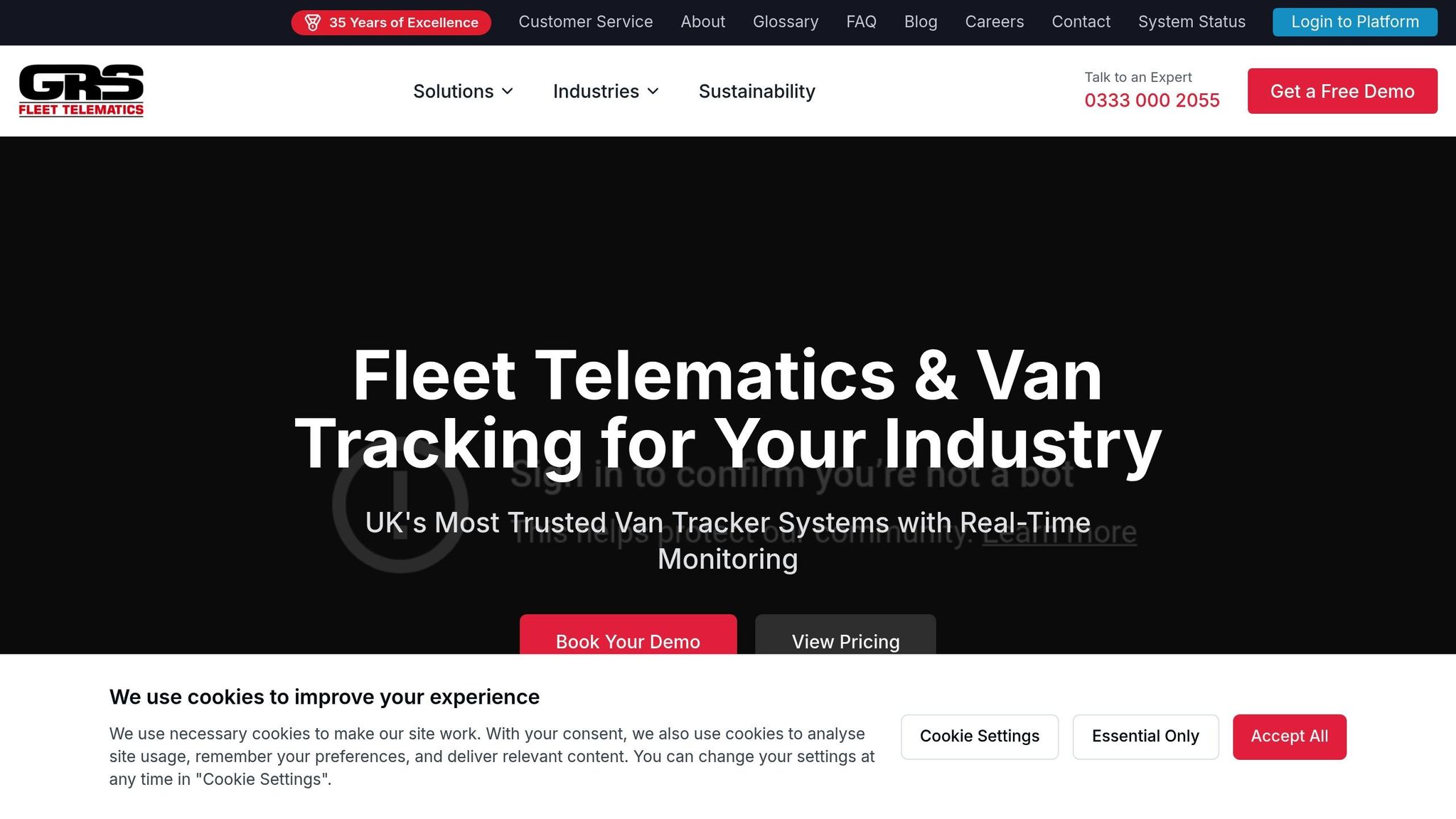How Remote Immobilisation Aids Stolen Vehicle Recovery
Explore how remote immobilisation technology enhances vehicle recovery rates, deters theft, and reduces operational costs for fleet operators.

Remote immobilisation is a powerful tool in combating vehicle theft, particularly for fleets. It allows fleet managers to remotely disable a vehicle's engine, preventing it from being restarted once turned off. This technology is paired with GPS tracking to locate stolen vehicles, achieving recovery rates of over 95% compared to the national average of 56.4%. Key benefits include:
- Faster recovery: Vehicles are often recovered within hours, reducing downtime and operational delays.
- Theft prevention: Immobilisation systems deter theft and unauthorised use by restricting vehicle access.
- Lower costs: Insurers may offer discounts of up to 20%, and businesses save on replacement vehicles and insurance excesses.
Systems integrate with telematics, offering features like geo-fencing, tamper alerts, and driver identification. Safety protocols ensure engines are only disabled when vehicles are stationary. Regular maintenance and collaboration with law enforcement enhance effectiveness.
For fleet operators, choosing a reliable provider like GRS Fleet Telematics ensures secure, cost-effective solutions tailored to business needs.
How Remote Immobilisation Works
Step-by-Step Guide to Remote Immobilisation
Remote immobilisation kicks in as soon as unauthorised access is detected, triggering an alert to the monitoring centre.
The GPS tracker immediately provides highly accurate location updates - within 2 metres - and notifies the owner of any unauthorised movement.
Next, a Secure Operating Centre (SOC) operator contacts the owner to confirm the theft and rule out any false alarms.
Once verified, the SOC informs law enforcement, sharing the vehicle's exact location and movement patterns. This helps authorities act quickly to intercept the vehicle.
Finally, with police approval, a digital signal disables the engine by cutting off key circuits. This only happens when the vehicle is stationary, ensuring safety.
"Detection rates will rise alongside arrests – thieves will have nowhere to hide because we will find them." - Thatcham Spokeswoman
This method has proven highly effective. Immobiliser technology has helped reduce car theft by around 40%, and vehicles with tracking systems are far more likely to be recovered than those without.
The entire process relies on advanced telematics systems, which add an extra layer of security for fleets.
How Telematics Systems Enhance Remote Immobilisation
Remote immobilisation is part of a larger telematics system designed to boost security and improve operations. These modern systems combine GPS tracking, geo-fencing, and driver identification to create a multi-layered defence.
- GPS tracking provides real-time location data accurate to within 2 metres, making stolen vehicle recovery faster and more efficient.
- Geo-fencing establishes virtual boundaries, ensuring vehicles stay within designated areas.
- Driver identification systems ensure only authorised individuals can operate the vehicle.
Beyond security, telematics systems offer real-time insights into vehicle location, speed, and driver behaviour. When integrated with fleet management software, they provide a complete operational overview, improving efficiency and reducing costs.
This combination of features delivers tangible results. For example, a London rental firm reportedly recovers £75,000 worth of stolen assets every year using these systems.
What’s Needed for Remote Immobilisation?
Setting up a reliable remote immobilisation system requires attention to both technical details and legal guidelines.
Hardware installation is the first step, typically carried out by Thatcham-approved engineers to ensure the immobiliser connects properly to the vehicle’s engine management system.
Mobile connectivity and GPS tracking are crucial for transmitting signals and providing precise location data during a theft. Adding driver identification, such as tags or credentials, further strengthens security. Some systems even offer a "no tag, one start" mode to handle anti-coercion situations.
Compliance with UK regulations is a must. This includes proper installation, maintaining valid insurance, and following protocols for working with law enforcement.
Additional features can enhance the system’s effectiveness. For instance:
- Tampering alerts notify operators of any unauthorised interference.
- Warning beepers alert users before immobilisation takes effect.
- Remote engine deadlock functions provide an extra layer of security.
For fleet operators, choosing systems that integrate smoothly with existing monitoring tools is key to ensuring seamless and uninterrupted operation.
Benefits of Remote Immobilisation for Stolen Vehicle Recovery
Higher Recovery Rates and Reduced Losses
Remote immobilisation transforms vehicle recovery into a swift and targeted operation. Telematics-based systems consistently outperform traditional methods, boasting recovery rates above 95%. Compare that to the national recovery rate of just 56.4% for stolen vehicles in 2020, and the difference is striking. While older methods might take days - or even weeks - to locate a stolen vehicle, telematics systems can often recover them within hours. This efficiency not only safeguards assets but also strengthens overall fleet operations.
For fleet operators, these higher recovery rates mean fewer financial setbacks. Costs associated with replacement vehicles, insurance excesses, and operational disruptions are significantly reduced, making remote immobilisation a practical and cost-effective choice.
Deterring Theft Before It Starts
Beyond aiding recovery, remote immobilisation acts as a powerful theft deterrent. A simple visual cue, like a "GPS Controlled" sticker, can discourage would-be thieves by signalling that the vehicle is equipped with advanced tracking and immobilisation technology. Even if a thief manages to gain access, the system can quickly disable the engine, preventing the vehicle from being moved. Studies show that immobilisers have contributed to a 40% reduction in car theft over time.
These systems aren’t just for theft prevention - they can also stop unauthorised use. For example, they can restrict company vehicles from being driven outside approved hours. This dual functionality enhances the system's overall value, offering both proactive defence and rapid recovery.
Cutting Downtime and Insurance Costs
Remote immobilisation delivers tangible savings through reduced vehicle downtime and lower insurance premiums. Insurers often offer discounts of up to 20% for vehicles equipped with trackers, acknowledging their effectiveness in reducing theft-related claims. Given that the average insurance payout for a stolen vehicle is £7,000, these systems can make a big financial difference. In 2020 alone, vehicle theft resulted in losses totalling £6 billion, with incidents occurring every 4.8 seconds, according to the National Highway Traffic Association.
Operational efficiency also sees a boost. Faster recovery times mean less downtime, which helps avoid productivity losses, vehicle hire costs, and scheduling headaches. For instance, GRS Fleet Telematics reports a 91% recovery rate. Their Ultimate package, priced at £99 with a monthly subscription starting at £7.99 per vehicle, includes remote immobilisation. These features quickly pay for themselves through lower insurance costs and reduced disruptions.
"The addition of Stolen Vehicle Tracking brings an additional level of peace of mind for our customers... confident that in the case that their Nissan is removed without their permission, they will be able to use their NissanConnect Services app to help the police identify its whereabouts and recover it." - Guillaume Pelletreau, Vice President of Electrification and Connected Services at Nissan AMIEO
Implementation and Best Practices
Choosing a Reliable Telematics Provider
Finding the right telematics provider is a critical step in implementing effective remote immobilisation. The provider's technology should integrate smoothly with your existing fleet management systems. Key features to look for include dual-tracker technology and recovery support, which help ensure system reliability.
Take GRS Fleet Telematics as an example. They offer a three-tier hardware system tailored to different needs. Their Essential package (£35) provides basic real-time tracking. The Enhanced package (£79) adds a secondary Bluetooth backup, boosting theft protection. For full immobilisation capabilities, the Ultimate package (£99) includes dual-tracker technology. Each package comes with a £7.99 monthly subscription, which covers SIM data, account management, and platform access.
When assessing providers, focus on recovery rates and response times. Systems with recovery rates exceeding 90% offer the reliability needed for robust fleet security. Additionally, the provider should offer 24/7 recovery support and maintain strong ties with UK law enforcement agencies. Integration with existing GPS tracking platforms and operational software is equally important, ensuring that remote immobilisation fits seamlessly into your broader security workflow. Lastly, the system must meet stringent UK legal and safety standards to ensure compliance.
Meeting Legal and Safety Standards
In the UK, remote immobilisation systems must comply with strict legal and insurance requirements. For instance, installing Thatcham-approved trackers is essential. Another critical safety measure is ensuring that immobilisation only occurs when the vehicle is stationary. This "safe stop" protocol prevents the engine from cutting off while the vehicle is moving, safeguarding drivers, passengers, and others on the road.
Access to immobilisation features should be restricted to trained and authorised personnel. Additionally, keeping detailed documentation for any diagnostic or programming equipment used with the telematics system is vital to meet regulatory standards. Following these measures strengthens your fleet's overall security strategy and ensures compliance with UK laws.
Training and System Maintenance
Training is a cornerstone of operating remote immobilisation systems safely and effectively. Security teams should undergo scenario-based training, covering areas like threat verification, safe timing protocols, and working with law enforcement. For example, a well-trained fleet manager once used a "recover mode" to assist police in retrieving a stolen vehicle within an hour.
Drivers also play a key role. Their training should focus on understanding the system and performing safety checks to avoid accidental activation. Since drivers are at the heart of fleet operations, their competence directly impacts both efficiency and safety.
Maintenance is just as crucial as training. Monthly checks should be performed to ensure GPS connectivity, test immobilisation hardware, and update software. Wiring integrity must also be verified to ensure the system fails safely in case of a malfunction. Regular refresher sessions should address legislative updates and new industry standards, promoting continuous improvement in fleet safety. Together, proper training and consistent maintenance uphold the effectiveness of remote immobilisation systems, boosting vehicle recovery rates and overall fleet security.
Teltonika Use Case: Secure Vehicle Disabling

Limitations and Safety Considerations
Understanding the limitations and safety concerns of remote immobilisation is key to incorporating it effectively into fleet security strategies.
When Not to Use Immobilisation
Activating remote immobilisation on a moving vehicle is extremely dangerous - it poses serious risks to drivers, passengers, and others on the road. To address this, modern systems are designed to delay the immobilisation command until the vehicle is fully stopped and the ignition is turned off.
Even when a vehicle is stationary, immobilising it in high-traffic areas or confined spaces can create additional hazards. Fleet operators should carefully evaluate the surroundings before issuing an immobilisation command to ensure safety.
Another challenge arises in vehicles without driver ID immobilisation. In such cases, thieves may restart the vehicle if tampering alerts are ignored. This highlights the importance of using remote immobilisation as a complement to traditional security tools - like gear locks or steering wheel locks - rather than relying on it as a standalone solution.
It’s also important to note that remote immobilisation systems cannot stop physical break-ins. Thieves may still access cargo, damage the interior, or bypass security systems before immobilisation takes effect. These limitations make it clear that strategic planning is crucial when deploying this technology.
Solving Technical Problems
Technical issues, such as GSM connectivity problems caused by blackspots or network congestion, can delay immobilisation commands.
To mitigate these risks, fleet operators can implement dual tracking units, fail-safe wiring with normally closed relay configurations, and anti-jamming measures to counter GPS and GSM interference. In London, nearly half of stolen cars involve advanced techniques like key cloning or electronic bypassing, which underscores the need for these precautions.
Regular system testing is also essential. Monthly checks should include verifying GPS connectivity, testing immobilisation hardware, and updating software. This helps identify potential issues early. Additionally, tamper alerts can notify fleet managers immediately if devices lose power or are manipulated.
Working with Law Enforcement
To ensure safety and compliance, vehicle shutdown commands should only be issued by operations centres, where trained personnel can make decisions based on safety protocols and police guidance. This centralised approach helps maintain control and reduces risks.
Collaboration with law enforcement is another critical component. Richard Billyeald, Chief Research and Operations Officer at Thatcham Research, stresses the importance of working together:
"Raising vehicle security alone will not prevent thefts, we believe that beating these criminals requires cooperation between government agencies, vehicle manufacturers and ourselves to reduce the value of stolen assets and therefore the incentive to steal them."
Fleet operators should establish clear communication channels with local police, sharing vehicle locations and immobilisation capabilities. This partnership allows authorities to coordinate safe recovery operations, enhancing the effectiveness of immobilisation technology.
Thatcham Research continues to focus on improving these systems. Billyeald further explains:
"We will continue to work with vehicle makers to improve vehicle security and establish how to remotely disable stolen vehicles in a safe manner, as well as making stolen parts more difficult to reuse"
This ongoing collaboration across the industry aims to strike a balance between theft prevention and public safety, ensuring remote immobilisation technology evolves responsibly and effectively.
Conclusion: Remote Immobilisation in Fleet Security
Remote immobilisation has become a key component in safeguarding fleets, offering fleet operators a robust defence against the increasing threat of vehicle theft in the UK. By integrating this technology, operators can enhance security, improve recovery rates, and optimise costs.
Key Points for Fleet Operators
Remote immobilisation technology delivers practical benefits, from significantly improving recovery rates to reducing operational expenses. For example, Thatcham-certified trackers boast recovery rates exceeding 96%, far surpassing traditional methods. Beyond theft recovery, this system helps prevent unauthorised use and supports safety compliance by disabling vehicles that fail maintenance or inspection checks.
"Remote immobilisation is an excellent tracking system feature to boost the security of your fleet, increase the chances of stolen vehicle recovery, and potentially reduce your insurance premiums."
- Crystal Ball
In addition to enhanced security, fleet operators also benefit from lower insurance premiums, reduced fuel costs, and decreased maintenance expenses. Given that thieves can steal a vehicle in under 60 seconds, having the ability to respond quickly is crucial.
Importantly, these benefits are achieved without compromising legal or safety requirements. For comprehensive protection, remote immobilisation should complement traditional security measures like gear locks and steering wheel locks. Choosing the right system involves considering business needs, fleet size, and vehicle types, while ensuring installations meet Thatcham standards.
The GRS Fleet Telematics Advantage

GRS Fleet Telematics offers fleet operators a practical and reliable solution for tackling theft and improving operational efficiency. Their dual-tracker technology, which combines GPS with a backup tracker, achieves a strong 91% recovery rate for stolen vehicles. This dual-layer system provides an edge over single-tracker setups.
The company’s three-tiered pricing structure ensures flexibility for fleets of all sizes. The Ultimate package, priced at £99, includes full remote immobilisation, while the Enhanced option at £79 offers dual-tracker protection. A monthly subscription of just £7.99 per vehicle ensures advanced security remains affordable.
GRS Fleet Telematics also supports seamless integration with existing fleet management tools, offers 24/7 recovery assistance, and provides white-label branding options. For those opting for fleet branding services, free installation is included, delivering a comprehensive theft prevention and operational efficiency solution.
With van thefts climbing 18% to 12,950 incidents in 2023, UK fleet operators face a pressing need for effective security measures. GRS Fleet Telematics provides the proven technology and dedicated support required to protect assets and ensure business continuity.
FAQs
How does remote immobilisation keep the vehicle and its surroundings safe during activation?
Remote immobilisation focuses on safety by only activating once the vehicle has fully stopped. This approach avoids shutting down the engine while the vehicle is in motion, reducing the risk of accidents or loss of control.
By cutting off the engine in a controlled way, this system safeguards both the vehicle and those around it. The process is designed to prevent sudden movements or disruptions, making it a dependable and secure option for recovering stolen vehicles without endangering anyone.
What legal requirements must UK fleet operators follow when using remote immobilisation systems?
In the UK, fleet operators employing remote immobilisation systems must adhere to data protection laws, including GDPR. This ensures personal data is handled responsibly and prevents any form of unlawful surveillance. Being open with employees about tracking and immobilisation practices is not just a legal requirement but also a way to build and maintain trust.
Operators must also consider the regulations outlined in the Crime and Policing Bill, which place restrictions on the use, manufacture, and distribution of certain car theft tools and devices unless they meet specific legal standards. Staying compliant with these rules is essential to avoid penalties and to uphold the safety and security of the fleet.
How does remote immobilisation integrate with fleet management systems to improve efficiency and security?
Remote immobilisation can work hand-in-hand with fleet management systems to boost both efficiency and security. With a centralised platform offering real-time control and monitoring, fleet managers can swiftly address issues like theft, unauthorised use, or other security concerns.
This setup also streamlines vehicle deployment, ensuring resources are allocated efficiently. Plus, automated alerts and immobilisation features can cut downtime, improve compliance, and help control costs - making fleet operations smoother and more secure.
